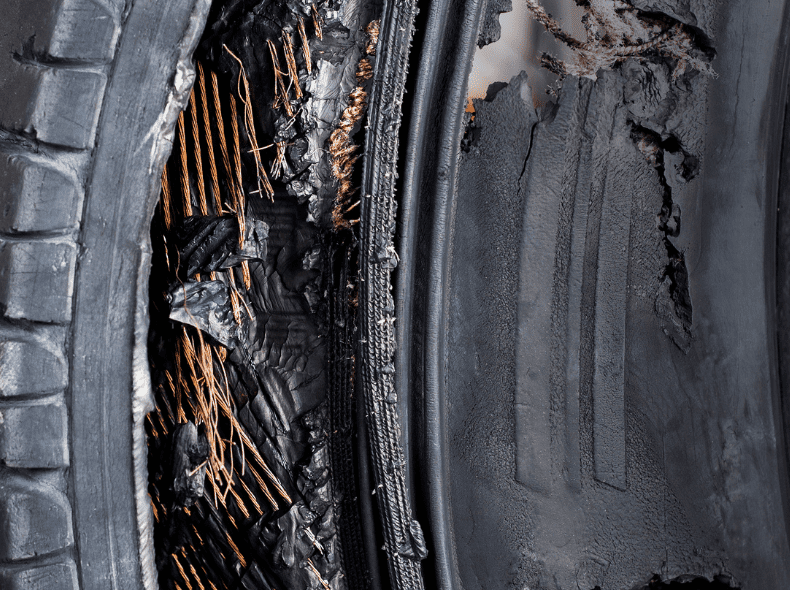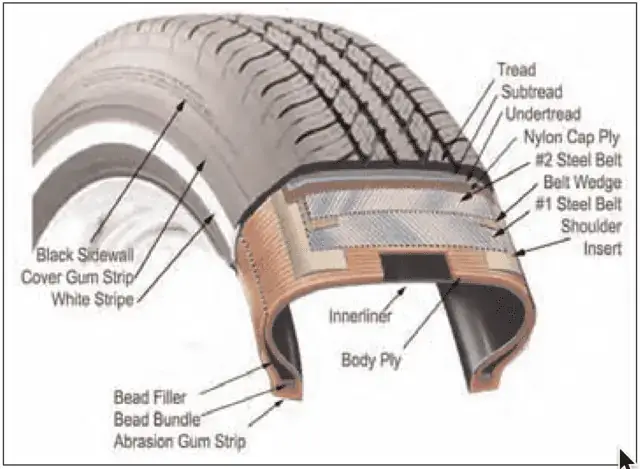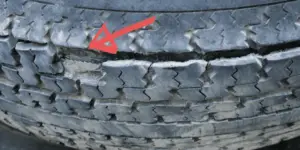So you checked your tire out and noticed a steel belt showing through the tread. This can be very alarming. You probably got lots of questions, the major one being whether it is dangerous.
In this article, we’ll explore if it is dangerous what a tire belt does and whether it can be repaired.
A broken tire belt can cause your car to veer off course suddenly and makes the car difficult to control. Tire separation resulting in a broken tire belt will mean your tire cannot be used again.
A broken tire belt occurring in poor weather conditions or on bad road surfaces can be extremely dangerous.
What Are The Symptoms of a Broken Tire Belt?
Steering Wheel Vibration
There are many causes of steering wheel vibration, and they are normally suspension or wheel related. A broken belt will mean that your tire does not turn smoothly.
These vibrations will run along the CV joint up the steering column and come out in your steering wheel. It may feel worse when you turn left or right, as this puts more pressure on the badly affected tire.
Weird Noises
If you hear a thumping noise as you accelerate or squeal as you slow down, these two sounds indicate a broken tire belt.
The thumping noise is due to your tire being out of round and no longer circular.
With a broken belt, there is more weight on a particular section of your tire, and this causes the thump as your wheel rotates as you travel along the road.
Tread Separation
Take a close look at the area between the shoulder and the sidewall. Are there signs of the rubber separating?

This is a sure sign that your tire belts in that section of the tire have failed. The tire belts during the manufacturing process are encased in rubber and should remain in place.
If they slip, cracks or gaps around the tire shoulder will be seen.
How Does A Tire Belt Break?
Poor Tire Manufacturing Process
Most tire brands use 1 or 2 steel tire belts in the manufacturing process. They are added just below the tread to add to the stability and durability of the whole tire.
You will not find belts in the sidewall as this requires flexing when you go over bumps, and belts would prevent this.
Although all tires are subjected to minimum safety standards, the manufacturing process’s quality varies between tire manufacturers.
The higher-end branded tires you are familiar with spend millions of dollars on research and development each year. They take great steps to ensure the durability and safety of their tires.
Smaller or newer manufacturers, although committed to safety, do not necessarily have the resources to stress test their tires as much as established popular brands.
Michelin spent $807 million in R&D in 2021 alone, while the most spent by a Chinses tire manufacturer was significantly less.
As with most research and development, the more done, the better the product is in the end.
It’s rare but sometimes the rubber chemical curing process that attaches the steel belts to the carcass doesn’t take well. If a batch of tires gets through the manufacturer’s quality control, they can enter the market. Tire belts not curing are dangerous.
This rarely happens, and the tires will be recalled as a matter of urgency. When this happens, the manufacturer will replace the tires free of charge.

In any case, should you see tire separation, whether they have officially been recalled you should contact the tire fitter or the time manufacturer directly and ask for compensation.
Most major tire brands will make their own steel tire belts in-house, whereas smaller ones may pool their resources and use a common type they have all invested in.
This could mean that if one steel belt is found defective, it could be installed in many different tire brands. As before, this is more likely to happen with the smaller and new tire brands on the market than the established ones.
It is rare for the tire belt itself to be bad; it’s more likely to be the process in which it was cured with the rubber and the polyester cords.
Further reading: Broken Tire Belts – The Symptoms and Dangers of Bad Steel Tire Belts
Gravel Roads and Potholes
Our roads seem to be getting worse every year. Poor road surfaces and potholes appear to be becoming the norm in many neighborhoods.
There is only so much you can do to protect tires, but in reality, they are always susceptible to road conditions due to their exposed position between you and the road.
Driving over a pothole at speed will cause your tire to very briefly lose its shape as the air in it is compressed by the impact. An impact with a pothole is often noticeable because of the damage done to a rim or wheel.

Although we’ll inspect the tire for damage and see none, a lot has been done inside the tire that isn’t obvious.
When you drive over a pothole, the tire belts can separate from the tread and fatally weaken its ability to cushion further impacts.
So, although your tire appears to be fine on the surface, inside, the tire belts are no longer fit for purpose, and the tire is dangerous.
Often, a driver will continue traveling on badly damaged tires, blissfully unaware of what has happened underneath the surface.
It is always best when you go over a large pothole or hit a curb to get the tire taken off at a tire shop to have them taken off the rim and the inside inspected.
Many visitors also read these related articles: Are Gravel Roads Bad For Tires? Help & Advice
Badly Worn Tires
Your tires would have to be extremely worn for them to impact the tire belts themselves.
The tread would have to be way below the minimum level and have eroded significantly into the carcass for the steel belt to be visible.
Even when a tire is dangerously worn, what may be considered a steel tire belt is actually polyester cords that are also used in the manufacturing processes. The polyester cord sits above the tire but beneath the tread.
Bad Driving Habits
Generally, this won’t cause your tire belts to fail, but I have included it for one reason: if you have selected the wrong tires for your car.
All tires have two ratings. A load and a tire speed rating. The speed rating on even the more basic tires is way more than the legal speed limit. However, if the car and tires are used beyond what is reasonable, the tire belts may fail.
Doing burnouts can cause the tire belts to fail dangerously.
They are not designed to be superheated in this way, and the rapid rise in temperature that would normally be dissipated by cooling air running over the tires as the car is driven can cause the tire’s structure to fail.
Can Broken Belts In A Tire Be Repaired?
A broken tire belt is dangerous and can’t be repaired. The tire belt meshes with the rubber carcass and cord at the factory.
There is no way this can be done away from a factory; even if it could, the cost would make it uneconomical.
The only option is to buy a new tire and do so as soon as possible. A tire with broken tire belts is dangerous, won’t repair itself, and will likely blow out the longer you drive with it.



![Does Cruise Control Use Brakes? [ANSWERED] Cruise-control-buttons](https://carzaza.com/wp-content/uploads/2023/12/Cruise-control-buttons-300x150.png)


![Can You Drive On Cracked or Weathered Tires? [ANSWERED] cracked-tread-on-tire](https://carzaza.com/wp-content/uploads/2023/12/cracked-tread-on-tire-300x224.png)






